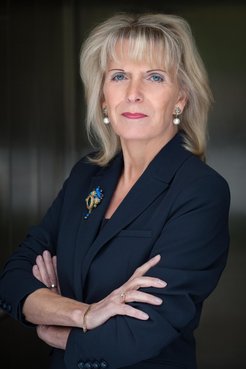The fascination of speech
Speech researcher Angela D. Friederici has always been fascinated by what happens in the brain during the process of speech and comprehension. By taking an interdisciplinary approach as a linguist, psychologist and neurobiologist, she has succeeded in overcoming the notorious gap between psychology and natural sciences and has gained a broad understanding of this medium in which we speak, read, think, write, email and tweet. Her findings have made her one of the world’s foremost researchers in the field of the neurobiology of speech. In our interview she talks about brain sections, the greatest linguist of all time and her own personal triumph.

Ms Friederici, nowadays modern computer technology allows us to view how the brain processes speech live, as it were. How has the field changed since you started your career as a speech researcher?
Radically! Just 40 or so years ago we were only able to gain insights into the brain by examining brain sections from patients with speech deficits caused by brain damage. For example, there was a stroke victim who could only speak in telegram style, stringing isolated words together. She had completely lost her grammar, although her intellect was otherwise fully intact. We concluded that if grammar is lost but the words are otherwise still there, the two must be stored at different locations. However, at the time we were only able to examine a patient’s brain after they died. Provided that patients had given their prior consent, their brain was dissected to see where the brain damage was located, that is, which regions of the brain had died. We then correlated those regions with the corresponding deficits. That’s how things were in the early days. We weren’t yet able to examine the living brain.
How have things changed?
For the past 15 years or so we have identified every convolution of the brain with the help of modern imaging methods, such as magnetic resonance imaging, or MRI for short. Of course, the questions posed by brain researchers have also changed. Today we can even investigate the subsystems of the major brain regions – not only where speech is processed but also precisely where grammar, word meanings and intonation reside.
However, just knowing where doesn’t really tell us much. What and how fast are also key questions. We’re able to address these questions with the help of electroencephalography, or EEG for short, which measures the electrical activity of the brain by sensing voltage fluctuations in the scalp. Speech comprehension occurs in the space of a few milliseconds. As we sit here speaking, for example, you’re giving no thought whatsoever to how you are processing speech. It all takes place automatically within half a millisecond – and that includes searching your memory to determine whether you already know something about the subject.
What exactly happens in the brain when we understand a word? Take the word “tree” as an example.
“Tree” is a simple example because we associate it directly with an object. First, we identify its word form: “OK, it appears to be a word in my language.” Then we consult our mental dictionary and sort it out from similar sounding words, such as “bee”, so we recognize it as a noun and find its meaning. However, not all the details about the word “tree” are stored in our mental dictionary. Another region of the cerebrum, the association cortex, now comes into play. It contains information about all the trees we’ve ever seen or even heard about.
The situation is far more complex when it comes to understanding abstract words, such as “because”. As soon as I hear that word, I know that it will be followed by an explanation. Such words form the basis of speech structure. It is this ability that distinguishes us from the capacity of all animals to form pure associations.
Can we only process words that we’ve already heard at least once and have stored in our dictionary?
That is indeed the case for adults. But the situation is particularly exciting in children, who hear new words day in day out. They recognise word forms after hearing them often and form associations. The system in children is incredibly plastic. For example, we carried out studies in which we showed 14-month-old babies an object we had cobbled together which they had never seen before. After we repeated what the object was four times, they understood and remembered. Isn’t that fantastic? Of course, abstract words that form the basic structure of speech, such as “because”, are more difficult and are only learned much later.
Speaking to you here, I am struck by your enthusiasm about the topic of speech. What especially fascinates you about this medium?
It’s what makes us human! So how can we not be interest in it? (She laughs.) A lot of animals are able to communicate with each other, but only humans possess true speech. Speech transcends space and time. Without speech, it would be very difficult to plan the future. And, of course, you can also learn things about the past through speech that pictures can’t convey, because they can’t explain why something is happening or happened in the past.
You are simultaneously a linguist, a psychologist and a neuroscientist. You therefore look at speech from various perspectives. Why’s that?
I chose this three-pronged approach in order to understand speech as a comprehensive whole. Linguistics provides the absolute theoretical foundation, meaning the study of speech in general. Then I wanted to know what mental processes take place while we’re processing speech, which led me to psychology. Finally, based on my experience with patients, I also wanted to gain insights into biological structures of the brain. Basically, it can be framed by the following question, which has driven me from the outset: Does the theoretical threefold division of speech into meaning, grammar and intonation have real biological correlates? And today we now know the answer: yes!
Do you sometimes find yourself between a rock and a hard place with these three disciplines? In other words, do such biological explanations meet with opposition from linguists?
Yes! (She laughs.) In a sense, my entire career as a scientist has been a struggle. I always wanted to mediate between the disciplines and to convince others that only an interdisciplinary approach can provide a complete picture about speech. Over the years, a certain openness has taken hold. Incredibly, this is reflected in one of the greatest linguists of all time, Noam Chomsky. He always wondered how humans, unlike apes, suddenly acquired speech. In his most recent book, Why only us?, he gives a possible explanation – a neurobiological explanation! He sees the key to human speech in the fibre bundles we described which serve as data highways between the brain regions, shuttling information back and forth in the brain. There is one specific fibre bundle that is not present in apes in the same form as in humans and that is still immature in children under three. It’s an explanation based on studies carried out here at our Institute.
So the linguist par excellence offers neurobiological explanations. That must be a personal triumph for you …
Yes, I suppose so. It is a triumph for our work: Chomsky, who only ever did theoretical work in linguistics, now accepts that the brain is a possible explanation. Noam and I had intense discussions about this. And now linguistic theory and neurobiology have found common ground.
We already know a great deal about speech thanks to your research and that of others. However, much remains shrouded in mystery. What other puzzles would you like to solve?
One question, among many other puzzles that intrigue me, is whether the universal grammar proposed by Noam Chomsky is reflected in brain structures, and if so in which. According to this theory, all languages in the world are based on grammatical rules that are hardwired into everyone. We want to find out how universal the fibre connections between our speech centres are as a fundamental biological framework and how they adapt to linguistic input.
Finally, I would like to ask your advice about the politics of the ongoing refugee debate, in which language is increasingly thought to be key to integration. What form should such language-driven integration take?
Learning German is certainly crucial to integration. We know from our studies that grammar is in fact the foundation for learning a language, even if it seems tedious at first. But without grammar, you never progress beyond a certain level in a foreign language. You can always learn more words later, even in old age. For the current situation we have to steer a middle course and consider the right learning method for each age group. In fact, there is a critical time, after which the plasticity and flexibility of our speech centres start to decline significantly, meaning that we find it increasingly difficult to learn. So you have to look at what is a sensible approach depending on an individual’s age: more grammar or more words. That’s what we plan to look at more closely in an upcoming research project.
We’re looking forward to the results. Thank you for the interview, Mrs Friederici.
The interview was conducted by Verena Müller, scientific editor at the Max Planck Institute for Cognition and Brain Sciences in Leipzig.












